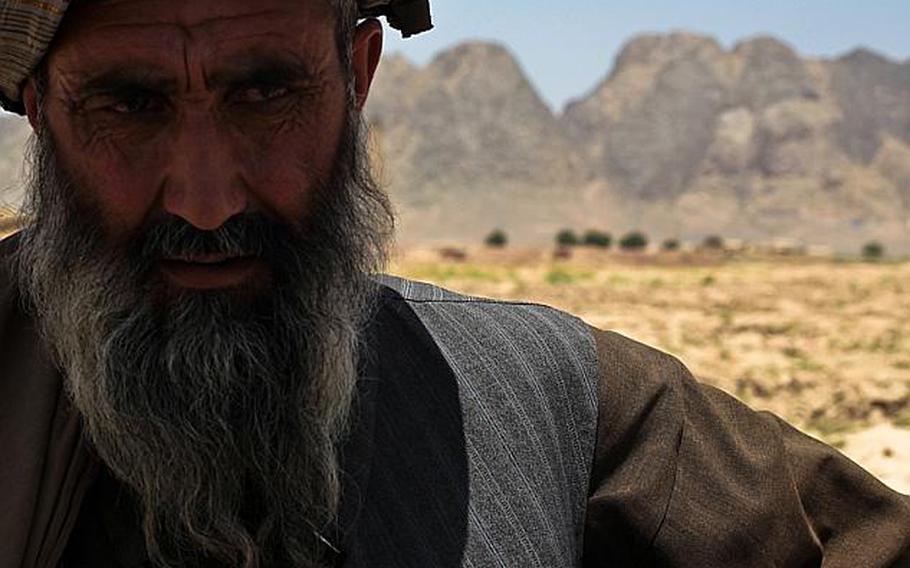
A man listens as U.S. troops with 1st Squadron, 71st Cavalry Regiment question him at a traffic checkpoint in Dand district, Kandahar province, Afghanistan. June 18, 2010. (Drew Brown/Stars and Stripes)
DEH-E-BAGH, Afghanistan — In June 2009, then commander of international forces in Afghanistan Gen. Stanley McChrystal hailed the counterinsurgency strategy employed by Canadian troops here as a “thinking man’s effort.”
NATO Secretary General Anders Fogh Rasmussen said the effort was “exactly the approach we will pursue in coming years.”
Now U.S. soldiers, who took over operations here in April, are trying to replicate the Canadian “key village” approach in other areas throughout Dand district, on the southern outskirts of Kandahar city.
American commanders say they see signs of success, with Afghan village elders and tribal leaders cooperating closely with them on security, governance and development issues in ways that are rarely seen in southern Afghanistan.
But the architect of the “key village” strategy says it’s unlikely to work as a model for counterinsurgency elsewhere in Afghanistan.
“The problem is that it’s years too late,” said Thomas H. Johnson, a research professor at the Naval Postgraduate School in Monterey, Calif. “It’s at least eight years too late in most places.”
Early last year, Canada brought in troops and Afghan police to boost security in Deh-e-Bagh, a village of about 900 people that serves as the seat of Dand district, while pouring in development dollars that resulted in a new government center, irrigation canals, paved roads and solar-powered street lights.
The idea was that instead of spreading aid projects and security efforts thinly across Kandahar province, the Canadians would concentrate resources in one village and spread outward.
Compared to the neighboring districts of Zhari and Panjwayi, where the Taliban insurgency is raging, Dand district, which covers 168 square miles and has a population estimated at 130,000, is an island of stability.
The basic focus on improving security, governance and development is not radically different from the approach that U.S. and other NATO forces are trying elsewhere in Afghanistan. But in Dand, village elders and leaders are cooperating, according to U.S. officers.
“They’re buying into their own processes,” said Lt. Col. John Paganini, commander of 1st Squadron, 71st Cavalry Regiment. “The maliks (leaders) are turning to the district governor. They’ve stopped coming to us for everything. The district-level shuras are now deciding how they should allocate resources. ... To me, that’s success.”
U.S. forces have learned from years of war in Afghanistan and in Iraq that “you don’t do security independent of governance, and you don’t do governance independent of development,” Paganini said.
“They all have to happen simultaneously or near simultaneously,” he said. “Security built without the idea of a better tomorrow … doesn’t work. It’s short-term security. We’ve proven that for the last few years here. But security that’s coupled with a government that’s meeting the needs of its populace through specific and targeted development programs, that’s what achieves success.”
But Johnson says the project in Deh-e-Bagh worked because there were only two major Pashtun tribes in the village, which made for a relatively homogenous population and one generally free of the tribal and ethnic rivalries that complicate other areas of Afghanistan.
Also, the Canadians did a lot of “up-front work” in getting consensus among the village and tribal elders before they launched the operation, Johnson added.
“There were 200 elders who signed a letter telling the Taliban they liked what was going on there and not to mess with it,” he said.
Money is clearly the carrot that brought many of the elders to the table and kept them there. Canada has spent $15 million in Dand since 2007, said Capt. Yves Desbiens, a spokesman for Canadian forces in Kandahar province. U.S. troops anticipate spending several million dollars more before their tour ends in April.
“Before, people were helping the Taliban because there was no work in our villages,” said Haji Daud Khan, leader of the Rambassi village development council. “Now the people are working in their own villages. The people also know that Canadians and Americans aren’t here to stay in their villages and country forever. They’re only here to help.”
Capt. John Villasenor, commander of Troop B, estimated that infrastructure projects — digging an irrigation canal here, refurbishing a school there — have employed about 1,400 men in his sector alone over the last two months.
“This is what we’ve wanted for the last 10 years,” said Yar Mohammed, the malik of Walakhan, another village in Troop B’s sector. “Most of our guys were jobless, but now they are working.
“The war in Afghanistan can’t be won by guns, tanks and airplanes. The only way to win is through these projects.”
But even as the approach seems to be working in Dand, Johnson says that U.S. and other NATO officials must not assume that it is a magic formula for success everywhere.
“In Afghanistan, all loyalty and identity resides at the local level,” he said, adding that Western military forces have to first understand the needs of the local area and who the key players and powerbrokers are before they can work with them effectively.
He also noted that the patience of many Afghans with U.S. and other NATO forces has worn thin, and that to try to employ the key village approach throughout Afghanistan at this point, almost nine years into the war, “borders on hypocrisy.”